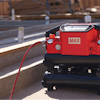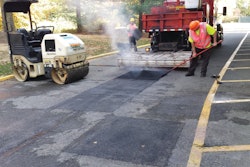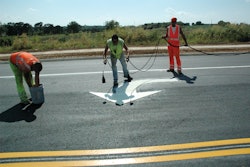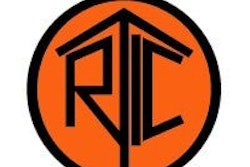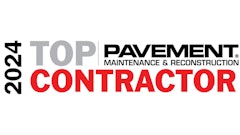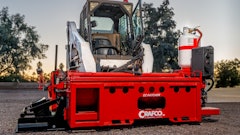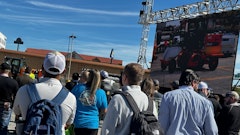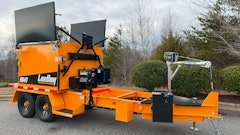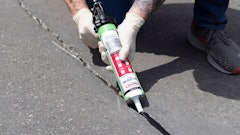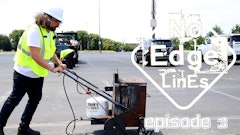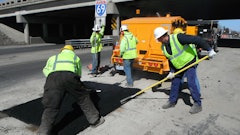
Looking to diversify your services? Trying to find a way to set your business apart from the competition? Ever considered adding infrared services to your business?
Infrared is a fairly new process that most customers, and many contractors, do not know about. Whether you've thought about it before or this is the first time the idea has crossed your mind, infrared services can offer many benefits to contractors in the pavement maintenance industry. "If you're tied to the asphalt industry at all, you can add the infrared unit to your arsenal and definitely benefit," says Joel Marshall, marketing and sales manager for Asphalt Reheat Systems. "You can sell the process because you are connected in some way."
Business benefits
It may be obvious, but a major benefit of adding infrared is the fact that you are adding another service to your business. With an extra service comes an extra revenue source. "They are tools that you add to your business that offer you the opportunity to make money; to provide a service and provide profitability to your business," says KM International Vice President of production Bryan Burke. But money isn't the only benefit of adding infrared services to your business.
Industry manufacturers agree that incorporating infrared into a current business gives a contractor an edge. "It's adding a niche that may set them apart from their competition," Marshall says. "Or, if the competition has them, then it's bringing them up to speed. It's going to show their customers that they are in touch with the latest technology and they care about their products and their services enough to research and give their customers the best product they can."
When it comes to repair, infrared allows contractors to provide an alternative to standard methods, such as repairing potholes with a shovel and cold mix. And learning to use infrared equipment can be relatively easy, says Ray-Tech Infrared Corp. President Wesley Van Velsor. "By watching someone who is accomplished in the art, and practicing, practicing, practicing, they will eventually become fairly proficient," Van Velsor says.
"I don't know of any other industry that anyone can earn so much while they learn. If they don't get it right the first time, they can reheat it and do it over again."
But versatility doesn't just apply to repair services. Adding infrared can give contractors a gateway into other market segments as well. (See the sidebar on page 38 for a sample list.)
Infrared equipment is a great tool when creating decorative asphalt. Although decorative asphalt won't appeal to every customer, it offers a contractor a chance to make his business unique in the customer's eye. And he can provide a service that is still fairly unknown to many clients.
"The decorative paving process can be highly profitable. One, because it's unique; not very many people can do it," Burke says. "Because it's very much a craft, if you're good at it, you get to charge appropriately for your craft. And it's in a different market place than a lot of the asphalt repair companies are accustomed to. It's a higher profit segment of the industry."
Another area contractors can pursue with infrared is thermoplastics. Thermoplastics are usually applied using torches as the heat source. To do this, a contractor needs dry pavement and warmer weather - not to mention the time.
But with infrared, a contractor can apply thermoplastic in less ideal weather conditions. The infrared dries the pavement as it heats it up. The thermoplastic can then be applied to the pavement and completed in a quicker time because an infrared heater can cover a larger area than a standard torch, Burke says.
Contractors can also use infrared equipment to offer services in the off-season. Being able to offer services at times other contractors can't can increase business and profit. "If you're one of the few who are willing to go out and work on the off-season, I believe that you have the luxury of charging a premium to the customer at that point in time," Burke says.
What to consider
Research is essential for any contractor considering adding infrared equipment, Marshall says. Determine what you want to use it for and where. Decide on your target markets and who your customers will be. Research the different manufacturers and equipment available. And make yourself familiar with the infrared industry itself.
Possibly the biggest concern for a contractor looking into infrared is the cost of the unit. Infrared equipment can range in price from the low thousands to more than $40,000, Burke says.
How much money can be budgeted for the purchase, use, and maintenance of the equipment must be taken into consideration before a contractor adds anything new to his or her equipment line, Marshall adds.
But cost isn't the only issue to consider. A contractor needs to make sure he finds a unit that will fit into his business and work with the services he plans to offer. Where a contractor does business - driveways, parking lots, roads, etc. - will also influence the unit he chooses to purchase.
It is important that contractors consider the planned use for the infrared equipment before they decide what size and configuration to purchase, Marshall says. Contractors not only need to consider the type and size of job the equipment will be doing, but also how often the equipment will be used.
"The more I keep my assets working, and working profitably, then the more money I make," Burke says. Larger units will be more of an investment but worth it if a contractor plans to use it often. If the unit will only be used as a part-time service, a smaller unit might be a better purchase.
However, Van Velsor says that some contractors will make the mistake of buying too small of a pavement heater. "You need equipment that is large enough to allow you to accomplish a dollar amount to make it all worth while," he says.
Infrared units in today's market have a wide range of sizes and configurations. They can range from covering 4-square-feet to 64-square feet, Marshall says. And they are available as walk-behind, truck-mounted, and trailer-mounted units. All units can be used for the same applications, but some may be a better choice than others depending on jobsite conditions.
Once you've made your equipment purchase it's time to market your new services. Marshall suggests listing the services on your website or putting a logo on your trucks. Another great marketing tool is demonstrations.
"When people see the process they can't help being impressed," Van Velsor says. "It makes a lasting impression well beyond the purchase order."
The limits of infrared
Using infrared technology and equipment to repair pavement failures, apply thermoplastics, or create decorative asphalt can definitely save a contractor time and money. Marshall says it typically takes 20 minutes from start to finish to repair a pothole with an infrared heater. But infrared is not a miracle cure for all pavement failures.
"It's definitely not the fix-all-sum," Marshall says. "That's kind of a misconception some people do have with these - they can go out and repair any problem with asphalt, and it's going to last. If there's a bad base issue the problem will likely come back after looking good for a year or two. There will be problem areas where a contractor needs to decide whether to use the traditional method or heater repair in order to give customers the quality patches they deserve."




